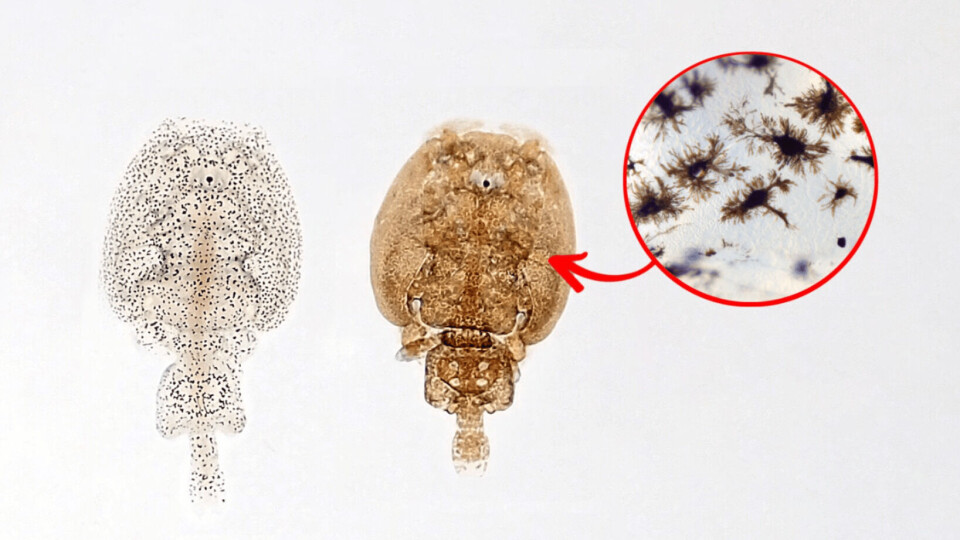
Study sheds sunlight on mystery of transparent lice
Transparent salmon lice might not have evolved to be invisible to cleaner fish – they might simply not have had a chance to get a suntan.
Unpigmented lice are known to create problems for wrasse and lumpfish put in pens to eat lice from the salmon because the cleaner fish can’t see them. This has led to a concern that lice are evolving so that cleaner fish will no longer be effective against them.
However, a new study in Norway suggests that sunlight plays a large part in how dark in colour lice become.
Researchers at the Institute of Marine Research (HI) and the Salmon Lice Centre at the University of Bergen (UiB) have made various attempts to find out whether salmon lice have adapted to the increased use of cleaner fish by becoming more transparent, or whether this is due to other things in the environment.
“There are many indications that it is the sunlight that affects the colour of the salmon lice. This is something we see in other species of crayfish as well,” says HI researcher Tina Oldham in an article published on HI’s website.
Get darker in the sun
The researchers first performed an experiment with two different groups of salmon lice. One group was kept outdoors in vessels with natural light, while the other group was in indoor vessels with artificial light.
Then the scientists compared the salmon lice and the degree of pigmentation they had.
“The lice that were bred outdoors were on average darker in colour, compared to those that had been kept indoors. This was independent of the sex of the salmon lice,” says Oldham.
In the same way that we humans get tanned by being in the sun, the salmon lice become darker in colour when they have been exposed to more sunlight.
Compared two different populations
To further investigate the hypothesis that salmon lice can adapt colour due to increased use of cleaner fish, they conducted an experiment in which they compared two different populations with salmon lice.
One group was defined by fish farmers as “transparent” and had recently been brought in from fish farms, while the other group were normal lice taken in from the Oslo Fjord more than 10 years ago.
The Oslo group has been grown in the laboratory without being in contact with cleaner fish, while the “transparent” lice were from pens where cleaner fish had been used over recent years.
Offspring from the two different groups of salmon lice were bred under completely identical conditions outdoors in daylight.
“We saw that the salmon lice that were defined as “transparent” became less pigmented and were slightly lighter than the “normal” group of salmon lice, says UiB researcher Lars Hamre.
The researchers also saw that salmon lice that sat on the back of the fish were darker than the salmon lice that were on the fish’s belly.
Deeper water produces lighter lice
In the pens, the salmon rarely stay close to the surface for a long time, and the light intensity decreases the deeper the fish swims.
In recent years, fish farmers have begun to use new technology that sinks the fish deeper into the water, such as snorkel cages, to prevent the salmon staying at the top where there are most salmon lice larvae. These are also factors that can lead to salmon lice becoming lighter and less pigmented because they are further away from the strong sunlight at the surface, says Oldham.
She explains that more research is needed to be able to measure whether a change is under way.
“Based on the experiments that have now been done, we can say that light has a lot to say for the colour, but we also see that there is a possibility that the change is genetic. To understand whether the lice are really becoming more transparent, we must document what the lice look like today under different conditions, and we must know which of the salmon louse’s genes determine how visible it is to the cleaner fish,” says Oldham.
Reference:
Hamre, LA, Oldham, T., Oppedal, F., Nilsen, F., & Glover, KA (2021). The potential for cleaner fish ‐ driven evolution in the salmon louse Lepeophtheirus salmonis: Genetic or environmental control of pigmentation? Ecology and Evolution. Contact: Lars Hamre (Lars.Hamre@uib.no), Frode Oppedal (FrodeO@hi.no), Tina Marie Weier Oldham (tina.oldham@hi.no).






















































